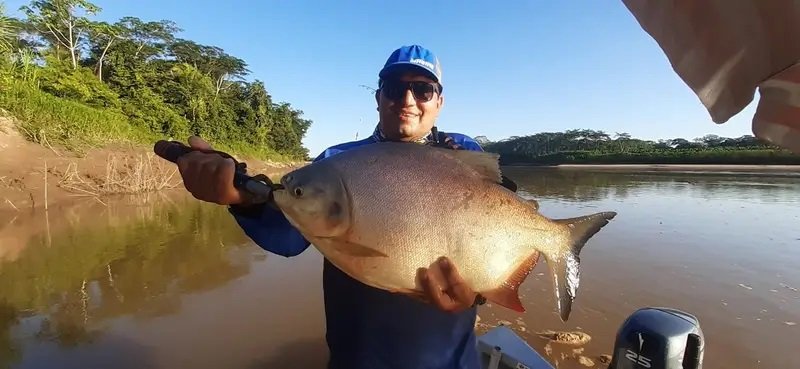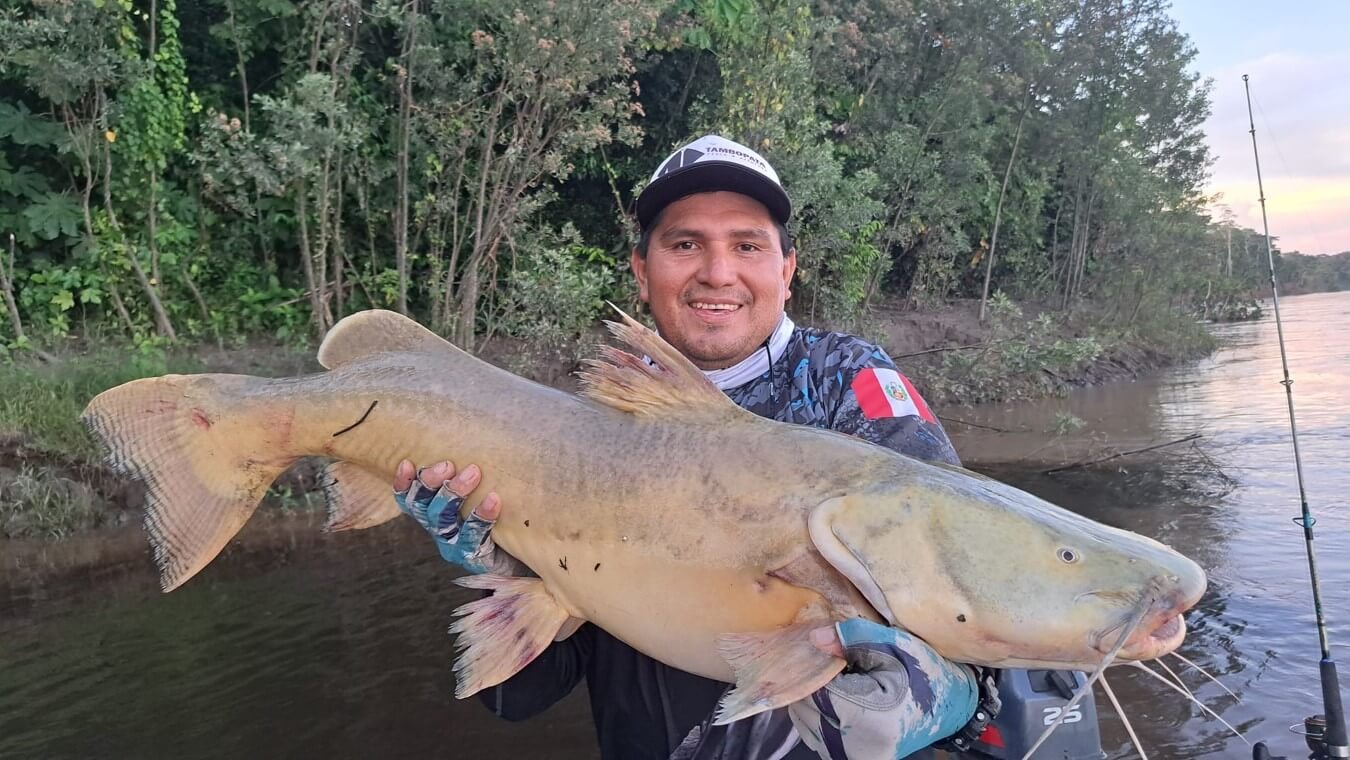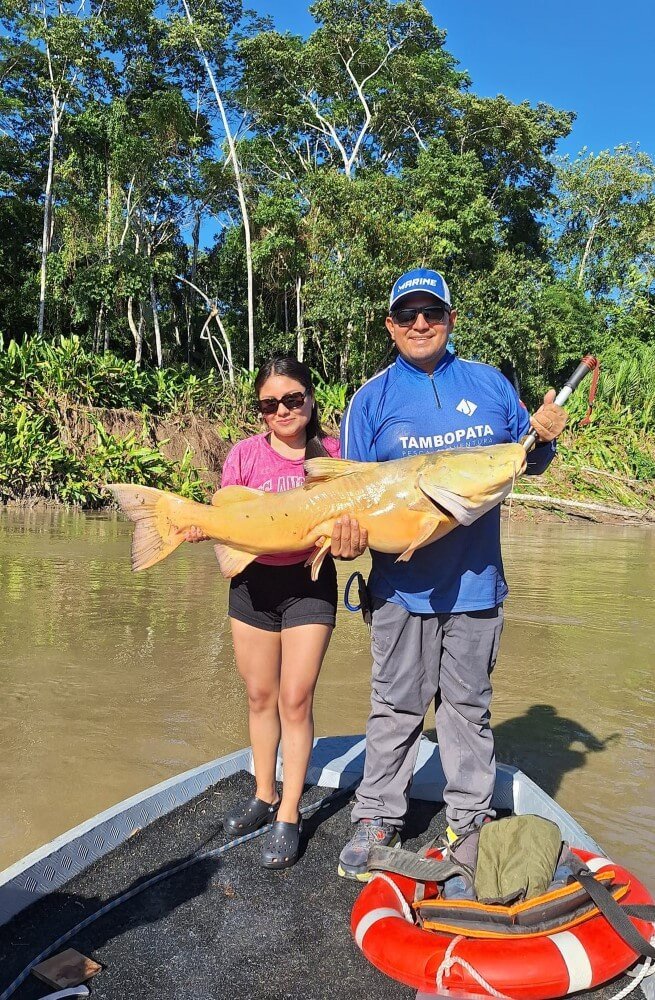Imagine a boat gliding over a crystal-clear river in the dense Bolivian jungle. The calm is only interrupted by the sound of your fishing rod as it casts into the water. You wait for a moment, and suddenly, an explosion. A fish leaps out of the water with immense aggression, fighting to shake off your hook. That’s the powerful peacock bass, one of the most coveted creatures by sport fishers. In Bolivia, this species is a true symbol of excitement and challenge. But what makes sport fishing for peacock bass in Bolivia so special? Let’s dive into this incredible experience.

Sport Fishing for Peacock Bass in Bolivia: The Peacock Phenomenon
Sport fishing has gained popularity in Bolivia, especially with the presence of the peacock bass (Cichla ocellaris). This fish, native to the Amazon basin and other large South American rivers, has found a perfect habitat in Bolivia to thrive, offering anglers an unforgettable experience.

The tributaries of the Amazon basin in Bolivia, with their warm and biodiverse waters, are the ideal home for peacock bass. These rivers provide the perfect conditions for their feeding and reproduction, leading to population growth that attracts both local and international fishers.
A Challenge in Every Catch: The Aggressiveness of the Peacock Bass
The peacock bass is a unique fish, not only for its striking appearance with vertical stripes and vibrant colors, but also for its fierce temperament. It’s a natural predator, famous for its aggression when attacking lures and small fish. This aggressiveness makes it one of the greatest challenges for any sport fisher.
When casting a lure into the river, anglers often anticipate the peacock bass to strike with all its might, creating a spectacle on the water’s surface. This generates a pure adrenaline rush, making sport fishing for peacock bass in Bolivia an unparalleled experience.
Why is Peacock Bass Fishing So Exciting?
One of the biggest attractions of the peacock bass is the intensity of the fight it puts up once it bites the hook. This fish does not give up easily. Fishers describe the battle as one of pure endurance and skill. Often, the peacock bass will make spectacular leaps, shaking vigorously to break free, keeping anglers on the edge of their seats, unsure whether they’ll reel it in or lose the catch at the last second.
Bolivia’s Rivers: A Paradise for Sport Fishers

Bolivia boasts a vast network of rivers that are home to the peacock bass, but among the most popular destinations for sport fishing for peacock bass are the northern rivers, like the Mamoré River and the Beni River, both tributaries of the Amazon. These rivers not only offer the chance to catch peacock bass but also allow fishers to experience one of the most biodiverse regions on the planet.
Additionally, Bolivia has promoted the practice of catch and release, a technique that helps preserve fish species, ensuring future generations of anglers can enjoy the same experience without harming the ecosystem.
Peacock Bass: A Warrior in the Rivers of Bolivia
The peacock bass is not just a large fish; it’s a true aquatic warrior. Its strength, combined with its speed and agility, makes it one of the most exciting catches for anglers. But it’s not all about brute force. This fish has a territorial and aggressive nature, defending its space in the water and attacking anything it sees as a threat, including fishing lures. This combative nature is what makes it so attractive to enthusiasts of sport fishing for peacock bass in Bolivia.
Peacock Bass Habitat: Secrets of Its Adaptation in Bolivia
The peacock bass is an adaptive fish. While its natural habitat is the Amazon basin, it has been successfully introduced to other areas of Bolivia. This fish prefers calm waters, especially those that are slightly murky or with moderate currents. Areas where water blends with dense vegetation, providing a rich environment full of prey, are ideal for this predator.
In Bolivia, the peacock bass has found refuge in lakes and man-made reservoirs, where it has been used to control invasive species and maintain ecological balance. This has allowed it to spread across various parts of the country, where fishers can enjoy catching it in diverse environments.
Peacock Bass or Tucunaré

There are five known species of peacock bass, all belonging to the genus Cichla and mainly distributed in the freshwater rivers and lakes of South America. The scientifically recognized species are:
- Cichla temensis
- Cichla ocellaris
- Cichla intermedia
- Cichla orinocensis
- Cichla monoculus
Although science has identified only five, some ichthyologists suggest there could be up to twelve different species in the region.
Peacock Bass Feeding: A Top Aquatic Predator
The peacock bass’s diet is as impressive as its character. This fish is a top predator in Bolivia’s aquatic ecosystems. It mainly feeds on smaller fish, but doesn’t stop there. The peacock bass can also attack larger prey such as lizards, iguanas, and even small mammals that fall into the water.
During fishing, one of the most thrilling methods to catch it is by using surface lures. These mimic the movements of small fish or other creatures, triggering a fierce attack from the peacock bass, offering a visual spectacle and a memorable fight.
A Sustainable Future: Conservation Through Sport Fishing for Peacock Bass
Sport fishing for peacock bass in Bolivia is not only exciting but also contributes to the conservation of the country’s aquatic ecosystems. Through eco-tourism and responsible fishing programs, the protection of Bolivia’s natural environment and biodiversity is promoted. Catch and release has become a common practice, allowing these majestic fish to continue living and reproducing, ensuring their presence for future anglers.
Moreover, the growing popularity of sport fishing for peacock bass has brought with it a significant influx of tourism, benefiting local communities. Economies in remote regions of Bolivia, especially in the Amazon area, have found in sport fishing a sustainable source of income, while protecting the environment.
Frequently Asked Questions about Tucunaré Sport Fishing in Bolivia

1. Why is the peacock bass such a sought-after fish in sport fishing?
The peacock bass is known for its aggression and strength when it strikes lures. Its fight is thrilling and challenging, offering a unique experience for anglers.
2. Where can you fish for peacock bass in Bolivia?
Peacock bass can be found in several rivers in Bolivia’s Amazon basin, such as the Mamoré River and Beni River. They can also be found in man-made lakes and reservoirs.
3. What techniques are most effective for catching peacock bass?
The most popular techniques include using surface lures, which trigger spectacular strikes, and fishing with live bait, like small fish or shrimp.
4. Does sport fishing for peacock bass contribute to conservation?
Yes, the practice of catch and release helps preserve peacock bass populations, ensuring future generations can enjoy this activity without harming the ecosystem.
5. What impact does sport fishing have on the local economy?
Sport fishing has boosted tourism in remote areas of Bolivia, creating jobs and promoting economic development in local communities.
6. What other species can be fished in Bolivia?
In addition to peacock bass, Bolivia’s rivers are home to a diverse range of fish, including dorado, pacu, and surubí, all popular in sport fishing.

Sport fishing for peacock bass in Bolivia offers an unparalleled experience for fishing enthusiasts. Its combative nature, Bolivia’s stunning landscapes, and the focus on conservation make this activity more than just a simple catch: it’s an adventure filled with excitement, respect for the environment, and contributions to local communities. If you’re looking for a challenge that will leave you with unforgettable memories, Bolivia is the perfect destination.





